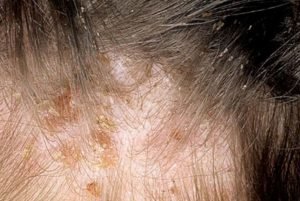

Getting red bumps on the scalp is actually a very common condition: usually, it’s a sign of an underlying medical condition which may or may not require treatment.
Bumps are skin disorders that commonly affect the face, chest, back, neck and in some cases the scalp. The condition is, however, more prevalent in teenagers but can also affect adults or even the elderly. Common signs and symptoms include large or small raised red bumps which may or may not be itchy, on your head.

Red bumps on scalp causes
Fortunately, with modern medicine and proper diagnosis, you can simply get rid of the underlying conditions causing the bumps on your scalp.
There are numerous factors which contribute to the formation of red bumps such as bacterial infections of hair follicles, fungal infections, clogging up of pores due to the buildup of dead skin and bacteria.
Generally, these bumps form the same way pimples do: normally, the sebaceous gland secretes sebum- “which is a mixture of fat and debris of dead-fat producing cells” and is connected to hair follicles. Pimples form due to overproduction of sebum which clogs up the pores on the skins.
Considering the fact that our scalp and hair are often exposed to a variety of external factors such as rough chemicals, dust and sometimes the lack of proper hygiene is grounds enough for promoting skin problems which may manifest as red, itchy bumps.

Scalp folliculitis
Folliculitis is the inflammation of hair follicles. This condition is commonly caused by a bacteria, fungal infection or irritation from shaving, using hair products(conditioners and hair dyes) with harsh chemical ingredients as well sweating too much.
In the beginning, the condition looks like little red bumps or white-heads around the hair follicles; later if or when it becomes severe it looks like puss filled blisters that break forming crusty sores that barely heal.
Treatment
Treatment depends on the severity and type of folliculitis, the self-care measures already tried and the patient’s personal preferences.
Medications: Antibiotic creams, lotions, gels or oral antibiotics: depending on the severity(mild-extreme) of the condition the doctor may prescribe either of the two treatment options. However, oral antibiotics are hardly ever prescribed unless the infection has become severe and recurrent.
Surgery: minor surgery may be performed in cases where there is a large boil or carbuncle. The procedure basically involves making a tiny incision to drain out pus from the infection. This procedure helps to reduce pain, speed the healing process and minimize scarring. The operated area will then be covered with a sterile gauze in case pus continues to drain.
Laser removal: in case all other treatment options fail, laser-hair-removal therapy may help to get rid of the infection completely.
This treatment option permanently eliminates hair follicles in the treated area.
This is a common scalp condition that manifests in the form of scaly, red bumps and dandruff. The condition is also referred to as dandruff, seborrheic psoriasis or seborrheic eczema, while in infants its referred to as cradle cap.

Scalp seborrheic dermatitis
The condition may go away without medical interventions but in some cases, you may need several treatments before the symptoms fade away. However, practicing daily routine cleaning with soap and shampoo can assist to reduce excess oil and dead skin cells build up.
Additional treatment options include the use of topical creams, ointments or shampoos to ease inflammation, antifungal oral medication or creams, gels and/ or shampoos.
Seborrheic dermatitis should be treated aggressively in the early stages to avoid complications such as hair loss.

Scalp acne or pimples
Scalp acne is characterized by red, non-itchy bumps on the scalp, however, it mostly affects people with oily skin.
The scalp contains sebaceous glands which secrete sebum to keep the scalp hydrated. Although, in some cases, sebum and dead skin cells plug skin pores, which forms the perfect setting for bacteria to thrive.
The excess oil build-up, scalp irritation, and bacteria lead to the formation of whiteheads or blackheads which may become inflamed, turn red and in some cases be filled with pus.
Treatment
Shampoos that contain salicylic acid or glycolic acid to naturally exfoliate the skin eliminate dead skin cells and prevent acne. Additionally, you can use natural antibacterial and antifungal agents such as tea tree oil and jojoba respectively to fight off scalp acne. Use a clarifying shampoo to remove product build-up, excess oil and any other debris from your hair.
Medical treatment: in cases of severe scalp acne its advisable to consult your doctor in order to get the best treatment. Also, if you have tried all sorts of over the counter medications and they seem not to work, consult your doctor.
Medical treatments may include the use of oral or topical antibiotics and/or steroid creams or injections.

Head lice on scalp bumps
The pediculosis capitis can easily infect your hair causing severe itchy and red bumps on the scalp. Though they are very tiny and difficult to be seen, it’s very easy to see their eggs (nits) at the bottom of the hair shaft.
Treatment
Treatment usually involves washing your hair with special medicated shampoos or other solutions containing 1% of permethrin. Additionally, you need to clean and disinfect your bedding and clothes with some torrid water and cleanse to remove lice and nits if any.
Prevention of scalp bumps may require lifestyle changes rather than using medical treatment only.
References